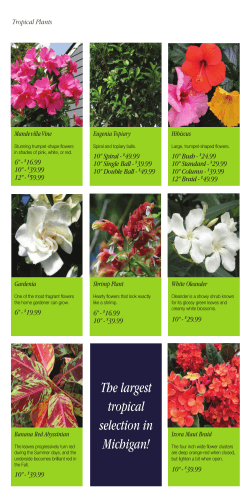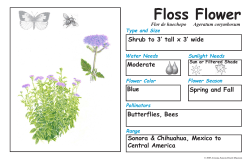
May 2015 - Mississippi State University Extension Service
VOLUME 8, ISSUE 5 COUNTY GARDENERS EXTENSION EXPRESS MAY 1, 2015 Cogongrass INSIDE THIS ISSUE: EVENTS 2 GARDEN CALENDAR 3 CHRISTIAN’S CORNER 4 SPECIAL POINTS OF IN TEREST: If you have comments about the newsletter or suggestions for future items, please contact: Eddie M. L. Smith, Ph.D. Co. Coordinator/Extension Agent MSU-ES Pearl River County Phone: 601-403-2280 E-mail [email protected] or Christian Stephenson Co. Coordinator/Extension Agent MSU-ES Hancock County Phone: 228-467-5456 E-mail [email protected] _________________ Discrimination based upon race, color, religion, sex, national origin, age, disability, or veteran’s status is a violation of federal and state law and Mississippi State University policy and will not be tolerated. Discrimination based upon sexual orientation or group affiliation is a violation of MSU policy and will not be tolerated. In April, you may have noticed pretty white puffy blooms on the side of the road, interstate, your pasture, your yard, or other areas. That was the seed head for the noxious weed known as Cogongrass. The noxious weed is found most frequently in southeast Mississippi but has been documented in 73 of 82 counties. Cogongrass has no nutritional benefits and is detrimental to forage crops. More than 100 years ago, Cogongrass entered the U.S. through the Port of Mobile and began its invasion of the South. Cogongrass affects pine productivity and survival, wildlife habitat, recreation, native plants, fire behaviors, site management costs and more. It is an invasive problem because it outcompetes native vegetation, taking over where other grasses once thrived. The most effective treatment is to spray a Roundup (Glyphosate) or Arsenal (Imazapyr) solution twice a year where Cogongrass has surfaced. The first of those two applications should be a spray mix containing 0.6 fluid ounces of herbicide per gallon of water, which should be applied just before flowering starts in April. The second spray should be a heavier dose applied in September or October. A spray mixture that contains 2.6 fluid ounces per gallon of Roundup or 1.3 fluid ounces per gallon of Arsenal. Upcoming Events Page 2 May 2015 1 Pearl River County Master Gardener Meeting— 12:30 p.m. Waterflo Productions and Nursery in Purvis. 8 Night Insect Collecting!— 6:30 until 9:30 p.m. Cr osby Ar bor etum, Picayune, MS. Many insects are emerging during the spring. Children will enjoy a night entomology event led by Hancock County Extension Agent Christian Stephenson, Collecting equipment will be provided. Bring your flashlight! Members free; nonmembers, adults $5 and children $2. Please register by May 7 by calling 601-7992311. 13 Hancock County Master Gardener Meeting— 1:30 p.m. at Hancock County Extension Service Office. April Shower….— 12:00 noon until 1:00 p.m. Lynette McDougald, Instructor and Manager of The University Florist.. April Showers Have Brought May Flowers! Lynette will share ideas for flowers to 14 wear and carry, tabletop, and over-the-top! Her presentation will focus on enjoying the out of doors with personal flowers! Call your local Extension office to RSVP for the program. Organic Gardening— 6:30-7:30 p.m. Bay St. Louis Public Library, Seal Meeting Room. This program will cover organic growing for the home garden. Plant selection, garden planning, fertilization, and pest 14 control will be included. Questions are encouraged. The presenter will be Mr. Christian Stephenson, Hancock County Agriculture and Natural Resources Agent. Call 228-467-5456 to register for the program. 18 Fall Prevention— 11:30 a.m., Pearl River County Senior Center, Picayune, MS. The presenter for this program is Dawn Vosbein, Extension Agent. No registration is required for this program. 19 Ways to Eat Smart & Move— 10:00 a.m., Raine Street Senior Center, Poplarville, MS. The presenter for this program is Pat Jones, FNP Program Assistant. No registration is required for this program. The Native Orchids of South MS— 10:00 a.m. until 11:00 a.m. Cr osby Ar bor etum, Picayune, MS. Learn to recognize and enjoy many of the thirty species of orchids native to the Gulf Coast. There are many interesting species which are often overlooked by everyone but the most avid orchid grower. Glen 23 Ladnier, long-time orchid enthusiast and member of the Gulf Coast Orchid Society, will discuss habitats, plant and flower characteristics, and touch on common conservation techniques. Members free; nonmembers $5; nonmembers’ children $2. Register by May 22 by calling 601-799-2311. Roses in the Landscape— 12:00 noon until 1:00 p.m. Presenter: Dr. Lelia Kelly, Consumer Horticulture Specialist, Extension Professor. Dr. Kelly's presentation will explore the versatility of roses 28 in the landscape. Because roses differ in growth habit, size, flower color and type they can play many roles in the home landscape. Examples will be given as well as landscape design tips. Call your local Extension office to RSVP for the program. Arboretum Spring Botany Walk— 10:00 a.m. until 11:30 a.m. Explore the Arboretum’s native plant exhibits with Dr. Mac Alford, Herbarium Curator and Associate Professor at the University of Southern 30 Mississippi in Hattiesburg. After a short indoor discussion of plant taxonomy and ecology, the program will move outside for a field walk through the grounds. Free for members, $5 non-members. Call 601-799-2311 to register by May 29. Please help us save money and paper by switching to our e-mail newsletter list. If you would like to receive the newsletter by e-mail, send a request to [email protected]. Planting Garden Calendar: June Page 3 Plant Crape Myrtles in bloom to be sure of color. Replace turf in deep shade with ground cover: Liriope, Ajuga, or Jasmine. Set out Caladiums in shady areas. Plant summer annuals Ageratum, Cockscomb, Impatiens, Marigolds, Sunflowers, Four-o'clocks, and Periwinkle. Plant Tomatoes late this month to insure harvest late into fall. Cherry Tomatoes are a choice that are heat tolerant. Choose Daylilies now that they are in bloom for planting in your garden. Divide and replant Iris, cut leaves back to 6 inches after transplant. Plant Zinnias and Marigolds now for a second crop of flowers. Plant Snap beans, Lima beans, Cucumbers, Eggplants, Peppers, Squash, and Tomato plants. Gladiolus planted now will give lovely fall blooms. Fertilizing Fertilize Camellias with Azalea-Camellia fertilizer if not done earlier in the year. Fertilize Bermuda and Zosia grass. Fertilize Tomatoes, Cucumbers, and Zuccinis monthly with 5-10-10. Fertilize annuals and perennials. Pest Control Mow lawn in the morning to reduce the chance of starting Brown Spot (fungus). Remove Zinnias with powdery mildew and replant. Pruning Prune Oleander after blooming ends. Pinch Dahlias and Mums to assure a compact growth habit. Remove blackberry fruiting canes after harvest. Prune new canes to encourage side branching. Faded flowers should be removed from Daisy, Daylily, and other summer flowers. Prune out dead and damaged wood from trees and shrubs. In Bloom Ageratum, Althea, Balloon Flower, Bee Balm, Begonia, Blackberry Lily, Butterfly Weed, Coreopsis, Cornflower, Fevervew, Funkia, Gladiolus, Hollyhock, Japanese Iris, Lily, Nicotiana, Petunia, Phlox, Rose Scabiosa, Shasta Daisy, Sweet Pea, Verbena, Butterfly Bush, Golden-rain Tree, Hypericum, Mimosa, Stewartia, Sourwood, Vitex, Yucca, Jasmine, Crape Myrtle, Daylily, Geranium, Hibiscus, Hydrangea, Impatiens, Lantana, Morning Glory, Oleander, Plumbago, Portulaca, Purslane, Salvia, Veronica, Dusty Miller, Four O'clock, and Zinnia. Christian’s Corner Page 4 Edema Often mistaken for an infectious disease or insect gall, edema (oedema, corky scab) is a common problem for plants when humidity is high or they get too much water. Edema is most frequently caused when plants take up more water through their roots than can be transpired through the leaves. Under these conditions, water builds up in the internal cells of the leaves eventually causing them to burst. This leads to areas of dead cells that are visible as a blister, usually on the underside of the leaf. Although almost any broadleaf plant may be affected, some plants, such as begonia, cacti, geranium, ferns, violets, and tomato and beans are particularly susceptible to edema. Edema symptoms vary by the plant species and part of the plant affected. Usually, symptoms appear on succulent leaves and flowers as small, water-soaked blisters or warts. Individual blisters are approximately 1 to 2 mm in diameter, but may merge to form lines or large areas. The exposed area of the blister will frequently become brown or tan, with a corky texture. Edema can be controlled by several cultural practices, as well as by changes in the weather. Avoid irrigation or watering during cool, overcast humid weather. For potted plants, remove the saucers under the pot or discard any water that remains in the saucer 30 minutes after watering. Additionally, avoid over-fertilization, especially when plants are growing slowly. Keep soil fertility at optimum levels by testing the soil and following fertilization recommendations. If you are aware of previous problems with edema, keep this in mind when selecting plants and if possible, improve drainage around the plant to prevent the plant from taking up too much water.
© Copyright 2026









